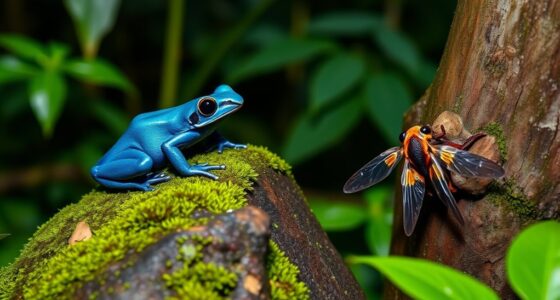To possum-proof your home humanely, start by securing food sources like trash cans and pet food. Clear dense vegetation and seal any entry points around your house. Use natural repellents like garlic, cayenne pepper, or essential oils to create an unwelcoming scent barrier. Installing physical barriers, such as tall fences, can effectively keep opossums out. Motion-activated devices, like sprinklers or lights, can also discourage their presence. Regular upkeep and changes in deterrents will prevent opossums from adapting. With these strategies, you can keep your home safe while respecting wildlife, and there's more to explore on effective methods.
Key Takeaways
- Implement habitat modification by sealing entry points and clearing dense vegetation to reduce hiding spots for opossums.
- Utilize natural repellents like garlic, cayenne pepper, and essential oils to create an unwelcoming environment.
- Install physical barriers such as solid fences and fine mesh to prevent opossums from accessing gardens and trash bins.
- Use motion-activated devices like sprinklers and lights to startle opossums and disrupt their nighttime foraging activities.
- Secure food sources by using animal-proof trash cans and removing fallen fruits to eliminate easy feeding opportunities.
Understanding Opossums
Understanding opossums is essential for anyone looking to keep these unique creatures at bay. As North America's only marsupials, opossums play a significant role in wildlife control by consuming pests like ticks—up to 5,000 each year! This helps mitigate pest issues and reduce the spread of tick-borne diseases.
You might find the Virginia opossum, the most common species in the U.S., particularly in southern, eastern, and midwestern regions. They can be quite clever and persistent, similar to how training dogs can require patience and understanding from their owners.
Opossums are nocturnal, meaning they're most active during the night. Their omnivorous diet includes fruits, insects, and small animals, making them opportunistic scavengers that will take advantage of readily available food sources. This adaptability can lead them to invade your property in search of food.
One fascinating defense mechanism they've is playing dead, which involves fainting and emitting a foul odor to deter predators. Understanding these behaviors can help you develop humane wildlife removal strategies.
Signs of Opossum Presence

If you suspect opossums are visiting your yard, spotting the signs of their presence can help you confirm your suspicions. Opossums are nocturnal creatures, so you'll likely notice their activity at night. Look for food scraps scattered around your trash bins or pet food left outdoors.
Here are some common signs of opossum presence:
| Sign | Description |
|---|---|
| Droppings | Dark, oval-shaped droppings resembling small dog or cat feces. |
| Tracks | Five-toed footprints with soft pads, often lacking claw marks. |
| Garden Damage | Missing fruits or uprooted plants indicating foraging behavior. |
| Vocalizations | Hissing, growling, or clicking sounds when threatened. |
Effective Habitat Modification

Making your yard less inviting for opossums can greatly reduce their presence around your home. Implementing effective methods for habitat modification is essential. By reducing habitat availability, you can deter these wildlife pests effectively.
Additionally, maintaining good indoor air quality with air purifiers can create a healthier environment, which is beneficial for both you and your pets.
Here are some simple steps you can take:
- Clear dense vegetation and brush piles that provide hiding spots.
- Seal all entry points around your home, such as gaps in foundations and attic access.
- Keep your yard well-maintained by mowing and trimming overhanging branches.
Additionally, eliminate standing water sources like clogged gutters or bird baths that attract opossums.
Store firewood and outdoor items at least 18 inches off the ground to minimize potential nesting sites.
Humane Deterrent Techniques

To keep opossums at bay, you can use humane deterrent techniques that work effectively without harming them.
Consider natural repellents, physical barriers, and motion-activated devices to create an unwelcoming environment for these critters.
For instance, utilizing unique indoor planters can't only beautify your space but also serve as an additional barrier against unwanted wildlife.
Natural Repellent Options
Utilizing natural repellents can effectively deter opossums from invading your home and yard. These methods aren't only humane but also safe for the environment and your pets. You can employ several natural methods for repelling these critters, and they're simple to implement. Here are a few options to take into account:
- Cayenne pepper: Sprinkling this spice around your garden can create an unpleasant environment for opossums due to its strong scent.
- Garlic cloves: Placing crushed garlic cloves in areas where opossums frequent can help keep them at bay with its pungent odor.
- Ammonia: Soaking rags in ammonia and placing them strategically can deter opossums, but be cautious as it can be harmful to pets and children.
Additionally, scattering pet hair in your yard mimics the scent of potential predators, encouraging opossums to steer clear.
If you're looking for a more dynamic solution, think about using motion-activated sprinklers. These devices startle opossums, providing a humane and effective deterrent.
Remember to regularly replace your natural repellents, such as vinegar and citrus peels, to guarantee they maintain their effectiveness.
With these strategies, you can create an unwelcoming environment for opossums without causing them harm. Understanding Toxicity to Cats is essential when using certain substances around your home.
Physical Barriers and Fencing
Natural repellents can be effective, but sometimes physical barriers offer a more permanent solution to keep opossums out of your yard. Installing a solid fence at least 4-6 feet high is essential, as opossums aren't great climbers but can dig under barriers. For added deterrence, consider using methods like garage door openers to enhance home security and prevent access points.
Make sure to bury the base of the fence to deter any digging attempts. Use fencing materials with fine mesh or solid walls; opossums can squeeze through openings as small as 4 inches.
To further enhance your fencing, consider adding an outward-facing overhang at the top. This extra barrier can effectively deter climbing attempts. Regularly inspect and maintain your fences and barriers, looking for any gaps or weaknesses that could allow opossums entry into your home.
If you have garden areas or compost bins, think about installing barriers around them to prevent opossums from accessing food sources. By implementing these physical barriers, you can create a more secure environment that keeps opossums at bay and protects your property from unwanted visitors.
Motion-Activated Devices
At night, when opossums are most active, motion-activated devices can serve as an effective and humane way to deter them from your yard. These devices startle opossums and create an unpredictable environment they'll want to avoid.
By incorporating motion-activated lights and sprinklers, you not only keep possums away but also add functionality to your outdoor space. Additionally, adopting a minimalist lifestyle, as seen in the Tiny House Movement Overview, can further enhance your outdoor experience by reducing clutter and fostering a connection with nature.
Consider these options:
- Motion-activated sprinklers: Water your garden while startling opossums with a sudden spray.
- Motion-activated lights: Illuminate your yard, creating a bright and uncomfortable atmosphere for nocturnal visitors.
- Combination devices: Use units that integrate both light and sound for an even more effective deterrent.
Regular maintenance of these devices is essential. Verify they're in working order to maximize their deterrent effect throughout the seasons.
By keeping these devices operational, you contribute to a consistent strategy for deterring unwanted wildlife. With the right setup, you can create a space that's not just beautiful, but also a safe haven from opossums and other pests.
Embrace these humane deterrent methods, and enjoy your yard without the worry of nocturnal visitors!
Natural Repellents and Scents

If you're looking to keep opossums at bay, natural repellents can be your best friend. Strong scents like garlic, cayenne pepper, and essential oils can create an unwelcoming environment for these critters.
Essential oils, derived from plants, provide therapeutic benefits and can also act as effective deterrents; for instance, peppermint oil is known for its strong scent therapeutic benefits of essential oils.
Effective Natural Repellents
Effective natural repellents can make a significant difference in keeping opossums at bay. By utilizing strong scents, you can create a less inviting environment for these critters.
Curiously, just as astrology can influence personal confidence and self-image, the methods you use to deter opossums can also impact how secure you feel in your space astrological compatibility and its effects.
Here are some effective options to contemplate:
- Garlic and cayenne pepper: Create a paste of garlic and cayenne pepper and apply it around entry points. The pungent aroma will deter opossums effectively.
- Essential oils: Oils like peppermint can serve as humane deterrent methods. Just remember, you may need to reapply them regularly to keep their potency.
- Pet fur: Scattering pet fur around your yard takes advantage of opossums' instinctual fear of predators, encouraging them to steer clear of your space.
Regularly replacing and combining these natural repellents can enhance their effectiveness since opossums may adapt to familiar scents.
You'll want to monitor your yard and adjust your strategies as necessary. While ammonia, bleach, and vinegar can temporarily repel opossums, they won't be foolproof, especially if food is involved.
Stick with these effective natural repellents to keep opossums away and maintain a humane approach to pest control.
Scent-Based Deterrent Strategies
Creating a scent barrier is a powerful way to keep opossums away from your home. You can use various scent-based deterrents to create an unwelcoming environment for these critters. Natural repellents like ammonia, bleach, and vinegar release strong odors that may deter opossums, but keep in mind their effectiveness can be temporary.
Additionally, you might consider using essential oils such as eucalyptus and peppermint, as they can provide a natural alternative to synthetic repellents while enhancing your outdoor space.
Incorporating garlic cloves around your property can also help, as their potent scent is often unappealing to opossums. Essential oils, particularly peppermint, are another option worth considering. Just remember to reapply them regularly to maintain their repellent properties.
Additionally, planting strong-smelling herbs such as lavender and rosemary can create a fragrant barrier that may discourage opossums from entering your yard. These natural repellents not only smell great to you but can help keep those pesky opossums at bay.
However, be aware that opossums can become accustomed to certain scents over time, which might diminish the effectiveness of your scent-based deterrents. Regularly rotating or renewing your chosen scents can enhance your success in keeping your home opossum-free.
Combining Repellent Methods
By blending various repellent methods, you can enhance your efforts to keep opossums at bay. Combining natural repellents like garlic and peppermint oil with other deterrents creates a more hostile environment for these critters.
Additionally, maintaining a balanced approach to deterrents guarantees that your garden remains uninviting in the long term, similar to strategies for weight loss during climbs where consistency is key.
Here are a few effective approaches:
- Cayenne pepper and garlic paste: This combination overwhelms opossums' senses, making your garden less appealing.
- Predator scents: Using red fox urine can mimic the presence of a natural enemy, but remember to reapply regularly for maximum effect.
- Motion-activated sprinklers: Pair these with natural scents to create an alarming environment that keeps opossums on their toes.
Regularly replacing these natural repellents guarantees opossums don't become accustomed to the scents.
The key is to maintain a diverse range of deterrents, as this unpredictability can be highly effective.
By thoughtfully combining these approaches, you can considerably reduce the chances of opossums invading your space.
With persistence and creativity, you'll create a less inviting atmosphere for these nocturnal visitors.
Securing Food Sources

To keep opossums at bay, it's crucial to secure food sources around your home. Start by locking your trash cans with tight-fitting, animal-proof lids. Opossums are notorious for rummaging through waste in search of food scraps, so this simple step can make a substantial difference.
Next, clean up any fallen fruit from trees and bushes regularly. These sweet treats can attract opossums seeking easy meals.
When it comes to pet food, store it in sealed containers and avoid leaving food and water dishes outside overnight. This eliminates a major attractant for these curious critters.
You should also pay attention to your bird feeders; opt for enclosed designs and make sure no seeds spill onto the ground, as spilled seeds can lure opossums into your yard.
Lastly, manage your outdoor compost. If you have a compost pile, remove it or confirm it's securely contained, as decomposing food waste can be a tempting buffet for opossums.
Using Motion-Activated Devices

Deterrence is key when it comes to keeping opossums away from your home, and motion-activated devices are an effective solution.
These devices not only provide a humane deterrent but also create an environment that's less inviting for these nocturnal creatures.
Here are a few ways motion-activated devices work to deter opossums:
- Motion-activated sprinklers: They startle opossums with sudden bursts of water, making them associate your yard with an unpleasant experience.
- Motion-activated lights: These illuminate dark areas at night, disorienting opossums while they forage.
- Combined device use: Using both sprinklers and lights together notably enhances deterrence, guaranteeing your garden remains unwelcoming.
To maximize their effectiveness, it's important to regularly maintain and properly position these devices.
Verify that the sprinklers' sensors are clean and the lights are aimed at areas where opossums are likely to approach.
Professional Removal Options

When dealing with an opossum problem, seeking professional removal options can often be the most effective approach. Licensed wildlife control experts use humane methods to capture and relocate opossums, guaranteeing compliance with local regulations. These trained professionals utilize live traps specifically designed to minimize stress for the animals, allowing for safe relocation to suitable habitats.
Here's a quick overview of what to expect from professional wildlife removal services:
| Service Type | Benefits | Considerations |
|---|---|---|
| Consultations | Free assessments and tailored solutions | May require scheduling |
| Live Traps | Humane capture, reduced stress | Proper placement needed |
| Health Risk Management | Minimizes disease transmission | Requires professional expertise |
| Long-Term Solutions | Effective exclusion practices | Ongoing monitoring may be necessary |
Engaging these services not only guarantees safe handling of wildlife but also reduces health risks associated with diseases carried by opossums. By choosing professional removal options, you can effectively eliminate opossum problems and create a safer, more secure environment around your home.
Community Engagement and Awareness

Community engagement plays an essential role in addressing opossum issues effectively. By working together, you can create a more harmonious environment that respects these creatures while protecting your home.
Here are a few strategies to boost community involvement:
- Organize neighborhood clean-up days to eliminate food sources and shelters, reducing opossum attractants.
- Host workshops with local wildlife agencies to educate neighbors about humane removal strategies and legal considerations.
- Share effective deterrent methods, like motion-activated lights and securing trash, empowering everyone to take proactive steps.
Educating your community about the ecological benefits of opossums can also foster understanding. Highlight their role in pest control and how they contribute to a balanced ecosystem.
Establishing wildlife management groups can further promote awareness and provide resources on humane practices for dealing with opossums.
Frequently Asked Questions
What Will Keep Possums Away From Your House?
To keep possums away from your house, secure trash bins, remove outdoor pet food, seal entry points, maintain a clean yard, and use motion-activated lights or sprinklers to startle them away effectively.
How Do You Get Rid of Possums Without Harming Pets?
Imagine a medieval knight defending your castle; you can create a safe haven by securing trash, using natural repellents, and employing noise-makers. These methods'll help keep possums away without putting your pets at risk.
What Is a Natural Pest Control for Possums?
You can use natural pest control for possums by securing food sources, using strong-smelling substances like garlic, and creating noise with wind chimes. Keeping your yard clean also helps deter these opportunistic feeders effectively.
What Is the Best Way to Euthanize a Possum?
Choosing to euthanize a possum is like steering through a stormy sea; it should only happen as a last resort. You must follow local laws, seeking professional help for humane methods that respect wildlife's crucial role.
Conclusion
By taking the steps to possum-proof your home, you're not just protecting your space; you're creating a sanctuary for both yourself and these misunderstood creatures. Think of it as building a friendly fence around your garden—one that keeps pests out while letting nature flourish. With the right methods and a little patience, you can share your neighborhood with opossums without conflict, ensuring peace for everyone under the same roof of your community.










